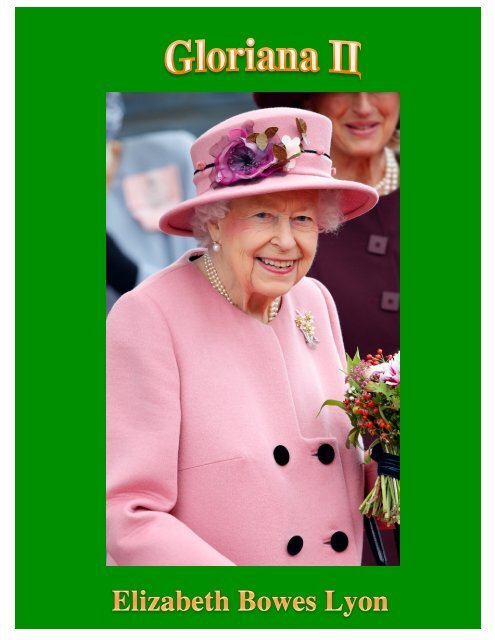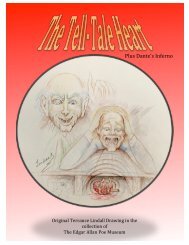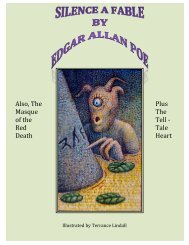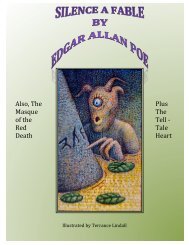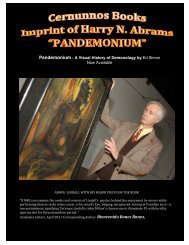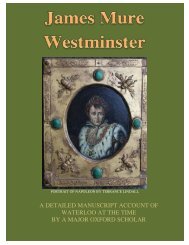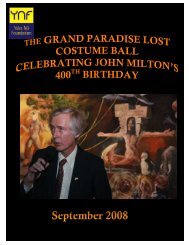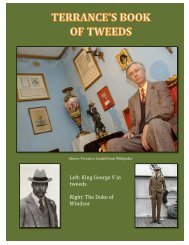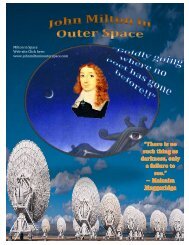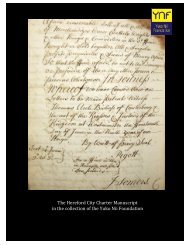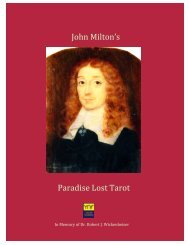Queen Elizabeth 2022 - Lady Bowes Lyon
The roots of Queen Elizabeth II - Glamis castle
The roots of Queen Elizabeth II - Glamis castle
Create successful ePaper yourself
Turn your PDF publications into a flip-book with our unique Google optimized e-Paper software.
119
The Yuko Nii Foundation owns many historical objects and<br />
ephemera related to the British Royal Family. Here is a letter from<br />
<strong>Queen</strong> <strong>Elizabeth</strong> to the Lord Chamberlain:<br />
<br />
120
The Last Will and Testament of<br />
Frances Dora <strong>Bowes</strong>-<strong>Lyon</strong>,<br />
Countess of Strathmore and Kinghorne<br />
<br />
121
The 14th Earl of Strathmore and his family in 1905 the year after he<br />
inherited the Earldom. <strong>Lady</strong> <strong>Elizabeth</strong> is at the front being held by the Earl<br />
A golden memory<br />
One of young <strong>Elizabeth</strong>’s earliest memories is of her<br />
grandparents’ (the 13th Earl & Countess) Golden<br />
Wedding celebrations in 1903, when she sat on her<br />
grandfather’s knee to watch the fireworks. When<br />
<strong>Elizabeth</strong> was four her grandfather died and her father<br />
inherited the Earldom, and with it, Glamis Castle. <strong>Lady</strong><br />
<strong>Elizabeth</strong> and the family thereafter divided their time<br />
between Glamis, St. Paul’s Walden Bury and Streatlam<br />
Castle in County Durham.<br />
<br />
122
Frances Dora <strong>Bowes</strong>-<strong>Lyon</strong>, Countess of Strathmore and<br />
Kinghorne (née Smith; 29 July 1832 – 5 February 1922) was a British<br />
noblewoman. She was the paternal grandmother of <strong>Queen</strong> <strong>Elizabeth</strong><br />
The <strong>Queen</strong> Mother, and thus a great-grandmother of <strong>Queen</strong><br />
<strong>Elizabeth</strong> II. The Countess’s mother was Henrietta Mildred<br />
Hodgson (6 January 1805 – 19 November 1891) an English lady with<br />
both British royal and USA presidential genealogical connections.<br />
Through her Virginia ancestry, <strong>Queen</strong> <strong>Elizabeth</strong> II and her<br />
descendants are related to George Washington, with Augustine<br />
Warner Jr. and his wife Mildred Reade having been their common<br />
ancestors.<br />
Her Last Will and Testament<br />
Collection Yuko Nii Foundation<br />
By Terrance Lindall<br />
Information from various sources<br />
Copyright 2021 YNF<br />
<br />
123
the 13 th Earl and Countess of Strathmore <br />
<br />
124
The Williamsburg Art & Historical Center contains many paper<br />
treasures. But from the British Isles there is one set of documents<br />
which has a compelling history:<br />
The last will of testament of Dowager <strong>Lady</strong> Strathmore, the<br />
soliiciter’s copy, hand written and executed at the same time as the<br />
original with original signatures.<br />
The WAH Center houses the last will of testament of Dowager <strong>Lady</strong><br />
Strathmore, including her marriage contract and the entire inventory<br />
of Glamis Castle. The <strong>Lady</strong> Strathmore was the mother to the <strong>Queen</strong><br />
Mother of England who died recently at the age of 101 years in 2002<br />
AD. She was one of the most beloved of the British monarchs.<br />
During the Second World War, when the Nazi’s were bombing<br />
London, she refused to move to the safety of the countryside.<br />
preferring to remain “with her people.” The Earl of Strathmore and<br />
his wife lived in Glamis castle. One of most legended castles in the<br />
world, it is “ a soaring pile of keep and towers, turrets and<br />
battlements.” It is said to have more dark secrets than any castle in<br />
Britain. And it has numerous ghosts. The gentlest ghost and most<br />
often seen is the "Grey <strong>Lady</strong>." She appears in the chapel.<br />
Few families are older than the <strong>Bowes</strong>-<strong>Lyon</strong>s, The <strong>Lady</strong> and Earl of<br />
Strathmore. They had their own army 600 years ago and their own<br />
private hangman. King Malcolm II of Scotland was murdered here.<br />
Shakespeare placed the murder of Duncan by Macbeth in the stone<br />
floored vaulted Duncan’s hall of the castle. And when the <strong>Queen</strong><br />
mother was a child, she and her sisters always scuttled at top speed<br />
through this room.<br />
<br />
Young <strong>Elizabeth</strong> at Glamis<br />
125
<strong>Lady</strong> Glamis (Janet Douglas)<br />
was burnt by James V as a witch and now<br />
haunts Glamis Castle as “The Grey <strong>Lady</strong>”<br />
<br />
126
The Grey <strong>Lady</strong> is not the only ghost to haunt its halls. The most<br />
appalling legend of all if of the toungeless woman, The late Sir<br />
David <strong>Bowes</strong>-<strong>Lyon</strong> is said to have seen her while taking a late stroll<br />
after dinner on the lawn. There he saw the girl gripping the window<br />
bars and staring distractedly in to the night. He was about to speak<br />
to her when she disappeared abruptly as if someone had torn her<br />
away from the window. There came one appalling scream – then<br />
utter silence. It as one minute to midnight. The Toungueless <strong>Lady</strong> is<br />
said to be a vampire whom the lords had punished savagely. Since<br />
vampires do not die, it is a pretty thought that she lies entombed in<br />
the castle, her eyes closed, her teeth sharp, her menace still potent.<br />
<br />
Toungeless <strong>Lady</strong> of Glamis<br />
by Biemvenido Bones Banez<br />
127
I was in touch with the Glamis Castle Librarian. She was very nice:<br />
Dear Terrance,<br />
Thank you for your e-‐mail. You may be interested in the enclosed <br />
extract from The Rev. John Stirton’s book ‘Glamis A Parish History’ <br />
(Forfar, W. Shepherd, 1913) on the 13 th Earl and Countess of <br />
Strathmore, as well as the enclosed photograph of the couple on the <br />
occasion of their Golden Wedding in 1903. We also hold the diaries of <br />
Claude, 13 th Earl, for 1844 and 1861 to 1904 at Glamis. The peerage <br />
web site is helpful if you are trying to piece together the <strong>Bowes</strong> <strong>Lyon</strong> <br />
family history; for Claude, 13 th Earl, see <br />
http://www.thepeerage.com/p10083.htm#i100829<br />
Thank you again for passing on the scanned copies. It is amazing what <br />
can get buried in lawyers’ offices; their records can be a veritable <br />
treasure trove. I have listed a few lawyers’ collections over the years <br />
and they tend to cover a diverse (and sometimes surprising!) subject <br />
area. Please do not hesitate to contact me if you have any other <br />
queries and you are most welcome to visit Glamis in the future.<br />
With best wishes,<br />
Ingrid<br />
<br />
128
No family has had a more intriguing past. A lady Glamis was burnt by<br />
James V as a witch, yet a few years alter, Mary, <strong>Queen</strong> of Scots dined<br />
with the family and stayed the night. A monster is said to have dwelt<br />
in Loch Calder near the castle. There are many bricked up rooms in<br />
the castle. Somewhere in the sixteen-foot thick walls is the famous<br />
room of skulls, where the Ogilvies family, who sought protection<br />
from their enemies the Lindsay’s, were walled up to die of starvation,<br />
being no friends of the Strathmores. The tradition of the heavy pile<br />
contain much by its appearance and is impressive to the imagination.<br />
An 1845 illustration by R. R.<br />
McIan, from James<br />
Logan's The Clans of the<br />
Scottish Highlands showing the<br />
Ogilvie tartan<br />
<br />
129
I also inquired to the National Archives:<br />
Dear Mr Lindall,<br />
Thank you for your email of 1 November 2013.<br />
I'm afraid I'm not quite sure what you're asking about. The<br />
picture of the bundle of papers tied with a ribbon is too small for<br />
me to see what is typed on the top one. The other picture<br />
shows the Inventory of Claude <strong>Bowes</strong> <strong>Lyon</strong>, Earl of Strathmore,<br />
from 1904.<br />
We hold the official record of the latter under ref SC47/40/72,<br />
pp175-179. We also hold similar for Marianne, Dowager<br />
Countess of Strathmore, recorded in 1850, SC70/1/70, pp231-<br />
233.<br />
It is not impossible that the family and/or their lawyers kept<br />
copies of this information, although I don't quite know how it<br />
would have ended up in Williamsburg! However, I can assure<br />
you that we have the records we should have, and that the ones<br />
you hold are not part of the official records of wills and<br />
inventories in Scotland.<br />
Yours sincerely,<br />
Alison Lindsay | Head of Historical and Legal Search Rooms<br />
National Records of Scotland | General Register House | Edinburgh EH1 3YY<br />
<br />
130
The Haunted Homes and Family Traditions of Great Britain, pp. 462 - 465,<br />
by John Henry Ingram published 1897<br />
"It happened once, on a dark and stormy November night, that Earl <br />
Patie had been wearied by his forced inactivity from horse and <br />
hound — for it was the Lord's Day, and that means complete <br />
abstinence from all worldly pursuits in bonnie Scotland — and, at <br />
last, with oaths and curses, he called for a pack of cards, and <br />
comforted himself with the anticipation of a pleasant game. The <br />
ladies were at their devotions, so he called the servants to him, one <br />
by one; but never since the days of the feast in the New Testament <br />
were so many excuses invented to cover disinclination. Of all those <br />
who had humoured him so often, not one could be found, from the <br />
steward to the scullion, to take a hand with the wicked Earl. In <br />
desperation the chaplain was attacked; but he, too, proved <br />
temptation proof, and strengthened the rebellion among the <br />
menials by branding the pack of cards as 'devil's bricks,' and <br />
hurling terrible anathemas at the head of any wight who should <br />
venture on so terrible a desecration of the Sabbath. For a time <br />
there was dire confusion and alarm in the Castle; and at last Earl <br />
Patie, swearing tremendously, and consigning everybody around <br />
him to an unmentionable locality, seized a pack of cards and went <br />
growling away up the old oak stairs to his chamber, saying he <br />
would play with the 'devil himself,' sooner than be thwarted in his <br />
desire. <br />
<br />
Self Portrait Terrance Lindall, 1964<br />
131
"He had not sat long in the room before a knock came at the door, and a<br />
deep voice sounded from the corridor, asking the Earl if he wished a<br />
partner. 'Yes,' roared the Earl; 'enter, in the foul fiend's name, whoever<br />
you are.' And with that there entered a tall, dark stranger, wholly<br />
wrapped up in a cloak, who nodded in a familiar manner to the Earl, and<br />
took his seat on a vacant chair on the opposite side of the table. The Earl<br />
stared at his strange guest, and doubtless felt a momentary uneasiness as<br />
he remembered whom he had invited to play with him; but a look at the<br />
cards on the table reassured him, and they commenced the game in real<br />
earnest. The stranger, who did not remove his bonnet and cloak,<br />
proposed a high stake; and in reply the Earl said, if he were the loser,<br />
and had not wherewith to discharge his debt, he would sign a bond for<br />
whatever his guest might choose to ask. Fast and furious became the<br />
game, loud oaths resounded through the chamber, and the terrified<br />
menials crept up the corridor, wondering what brave man dared to bandy<br />
words with the wicked Earl, and who was sinful enough to hold his hand<br />
at the 'devil's bricks' on the Lord's Day. As they fearfully listened they<br />
could hear the fierce utterances of the Earl, and the fiercer and more<br />
unearthly utterances of the stranger, whose presence they were quite<br />
unable to account for.<br />
<br />
132
"At last the old butler, who had served the family for two generations, <br />
ventured close to the chamber-‐door and peeped through the key-‐hole; <br />
but no sooner had he done so than he fell back and rolled on the floor <br />
with a yell of agony that resounded to the remotest part of the Castle. <br />
In an instant the door was rudely torn open and the Earl came out with <br />
fury in his face, and told them to slay anyone who passed, while he <br />
went back to settle with his guest. But his guest was nowhere to be <br />
found. They searched the chamber through and through, but in vain. <br />
He was gone, and he had taken with him Earl Patie's bond, but what <br />
for the confused and startled Earl did not exactly know. Returning by <br />
the old butler, Earl Patie found him stunned and bruised, with a yellow <br />
circle round the erring eye; and then he told the terror-‐stricken <br />
menials that, as he sat at play, the stranger suddenly threw down his <br />
cards and said, with an oath, 'Smite that eye!' whereupon a sheet of <br />
flame darted directly to the key-‐hole, and the mysterious stranger <br />
disappeared. <br />
"Earl Patie lived five years before he paid his bond, but afterwards, on <br />
every Sabbath evening, the old chamber was filled with strange noises <br />
that echoed through the passages, as if the wicked Earl and the dark <br />
stranger were again wrangling and swearing over the 'devil's bricks.' <br />
For a time the unearthly noises were put up with, but at last the room <br />
was built up, and nothing now remains to tell where the chamber was <br />
where Earl Patie and his fiery guest played their stormy game of <br />
cards." Such is the story, according to local tradition, of the secret <br />
room of Glamis Castle. <br />
<br />
133
134
135
From the National Portrait Gallery<br />
<br />
136
137
138
From “Royal Splendor”<br />
<strong>Queen</strong> <strong>Elizabeth</strong> II’s maternal grandparents were the Earl and Countess of<br />
Strathmore. They were the parents of <strong>Queen</strong> <strong>Elizabeth</strong> the <strong>Queen</strong> Mother,<br />
who was born in Scotland. The Strathmores could claim ancestry to the<br />
Scottish king Robert the Bruce and they were also Scotland’s largest<br />
landowners. They were a “sporting, military family, their politics were<br />
conservative and their style old-fashioned” family. It was customary<br />
among the wealthy those days to divide their time among their many<br />
homes and the Strathmores were not short of houses. They had Glamis for<br />
an official family seat, where late summers and early autumns were spent.<br />
The elegant <strong>Queen</strong> Anne mansion of St Paul’s Walden Bury in<br />
Hertforhshire would serve as their weekend retreat. This was also the<br />
home of Lord and <strong>Lady</strong> Glamis before Lord Glamis succeeded his father<br />
to the title. The social season meant that the family would decamp to<br />
London, where they owned a huge townhouse in St. James’ Square.<br />
<br />
139
From St. Paul’s Website:<br />
St Paul’s Walden Bury is a notable landscape garden, laid out in the<br />
early 18th-century, covering about 50 acres.<br />
This is the childhood home of <strong>Queen</strong> <strong>Elizabeth</strong> the <strong>Queen</strong> Mother.<br />
Long avenues lead to temples, statues, lake and ponds. Flower<br />
gardens bloom in spring and summer, with beautiful displays of<br />
magnolias, rhododendrons, irises, lilies. Wild flowers are encouraged,<br />
especially cowslips, bluebells, spotted orchids.<br />
The surrounding estate, with its arable and livestock farm and its<br />
ancient woodland, is a traditional country estate set in the heart of the<br />
beautiful Hertfordshire countryside.<br />
The front of the house dates from 1720, notable for its charming<br />
architecture. There is also a substantial Victorian addition. Inside the<br />
beautiful Green Drawing Room and Red Drawing Room are decorated<br />
with very fine plasterwork.<br />
<br />
140
141
142
143
144
145
146
147
148
149
The 13 th Earl, Claude, had what is commonly known as an “edifice<br />
complex.” He liked to build and did much to improve the grounds of<br />
Glamis Castle, much in the same way as England was improving upon<br />
and expanding it’s Empire under <strong>Queen</strong> Victoria. He could afford lavish<br />
improvements to the Caste and grounds because of the financial<br />
holdings of the family brought to him in part when his predecessor, his<br />
older brother Thomas, who died in 1865. Among many holdings listed<br />
in the inventory copies owned by the Yuko Nii Foundation and dated<br />
1904 are: shares of the Royal bank of Scotland, North British and<br />
Mercantile Insurance Company, the Caledonian Railway Company, The<br />
Scottish Guardian Newspaper, and more. They owned various castles<br />
and other properties in England, Scotland and beyond, including<br />
Streatham Castle with various farming properties situated thereto.<br />
Essentially, the family’s investments expanded tremendously with the<br />
success of the British Empire, allowing them a very comfortable and<br />
privileged position as one of the leading noble families of Great Britain.<br />
Biarritz where Claude died in 1904 became more renowned in 1854<br />
when Empress Eugenie (the wife of Napoleon III) built a palace on the<br />
beach (now the Hôtel du Palais). European royalty, including British<br />
monarchs <strong>Queen</strong> Victoria and King Edward VII (who caused a minor<br />
scandal when he called H. H. Asquith to kiss hands at Biarritz in 1908<br />
rather than return to London for the purpose),[1] and the Spanish king<br />
Alfonso XIII, were frequent visitors.<br />
Biarritz's casino (opened 10 August 1901) and beaches make the town a<br />
notable tourist centre for Europeans, and East Coast North Americans.<br />
The city has also become more recently a prime destination for surfers<br />
from around the world, developing a nightlife and surf based culture.<br />
<br />
150
The Episode of Claude, the 13 th Earl, and the “Mad Mr.<br />
Henegage”<br />
In 1885 a peculiar episode occurred when invitations were sent out for<br />
a ball at the Hotel Palais Biarritz. Mr. Charles Heneage, who had put<br />
down his cousin Miss Chalfont up for one of the invitations, became<br />
enraged when he found it was to be held at a casino. Claude had just<br />
sat down to a breakfast of rolls and coffee at the Vila Bon Air when a<br />
letter was placed in front of him from this Mr. Heneage written earlier<br />
in the morning. Mr. Heneage was also of a respectable lineage from<br />
Hainton Hall in Lincolnshire. Mr. Heneage’s letter went on to accuse<br />
the earl of having invited Miss Chalfont to “a locality prior to that<br />
date used for immoral purposes.”<br />
Hotel Palais Biarritz<br />
<br />
151
In January 1886 Claude received another letter from Mr. Heneage<br />
saying of the location “ it is not suitable for this purpose since other<br />
vices beyond gambling have been permitted under public surveillance.,”<br />
and on and on Heneage rambled.<br />
A plethora of letters from Mr. Heneage went out to other members of<br />
the aristocracy and government officials. Many of the letters were<br />
shown to or sent to Claude from persons offended and dumbstruck by<br />
the tirades of “Mad” Mr. Heneage. Mr. Heneage’s own brother<br />
apologized for the behavior of Charles stating that there was nothing he<br />
could do to end the irrational behavior.<br />
Finally, fed up with the entire mess, Lord Strathmore took his revenge.<br />
He posted this in the drawing room of the Hotel l’Angleterre ( in his<br />
own handwriting) :<br />
One Mr Heneage, so they say,<br />
A dreadful row has made today,<br />
About the Ball committee.<br />
And very naughty words has used,<br />
And Palais Barritz much abused<br />
In Language which we pity.<br />
If Mr, Heneage be so pure;<br />
He’s much too good for us I’m sure,<br />
This Paragon of Virtue.<br />
So what could the Committee say,<br />
Except “You’d better stay away,<br />
For fear the place will hurt you!”<br />
1) Receipt from Ernestine Hester Maud Scott & Others<br />
<br />
152
153


